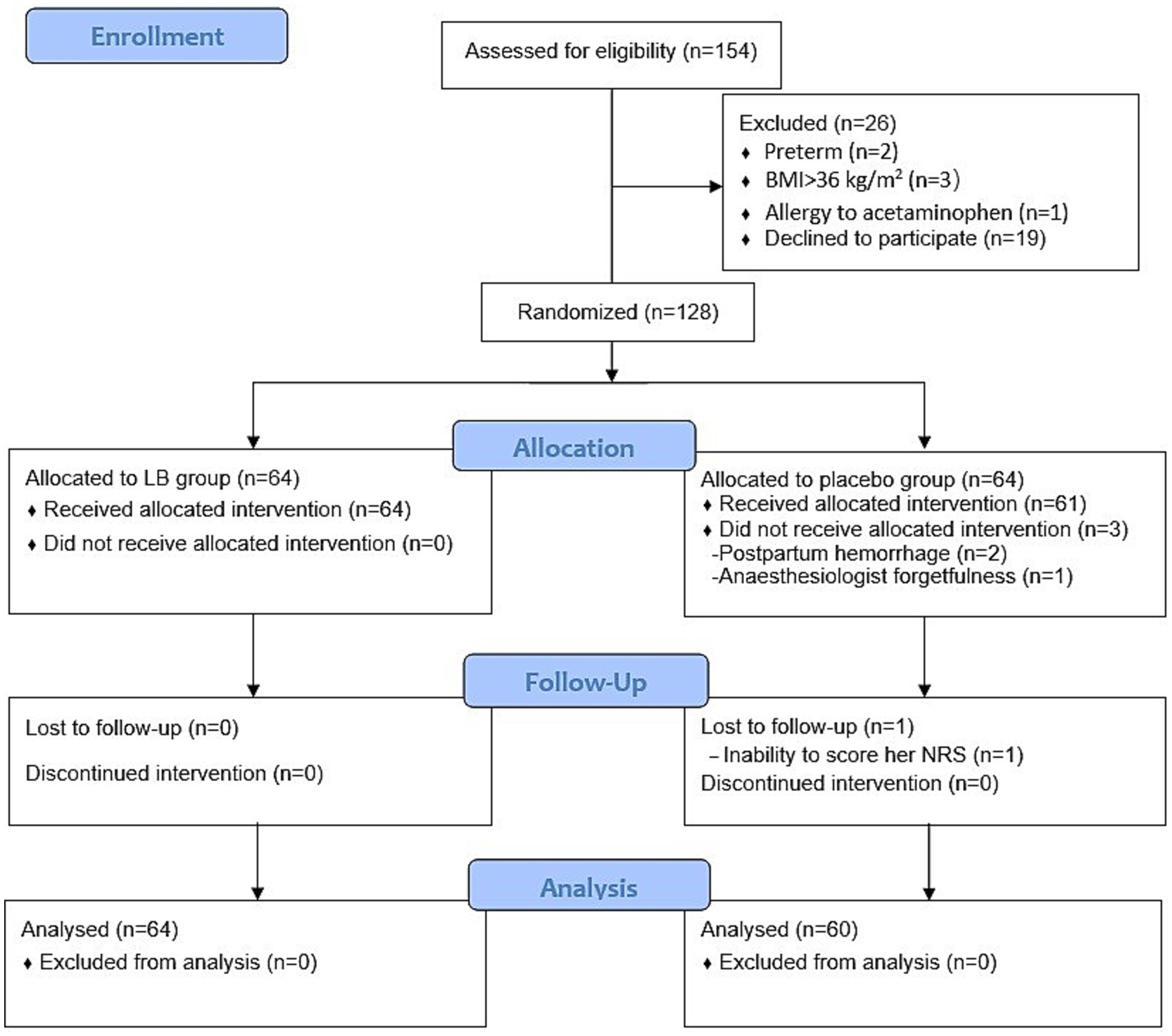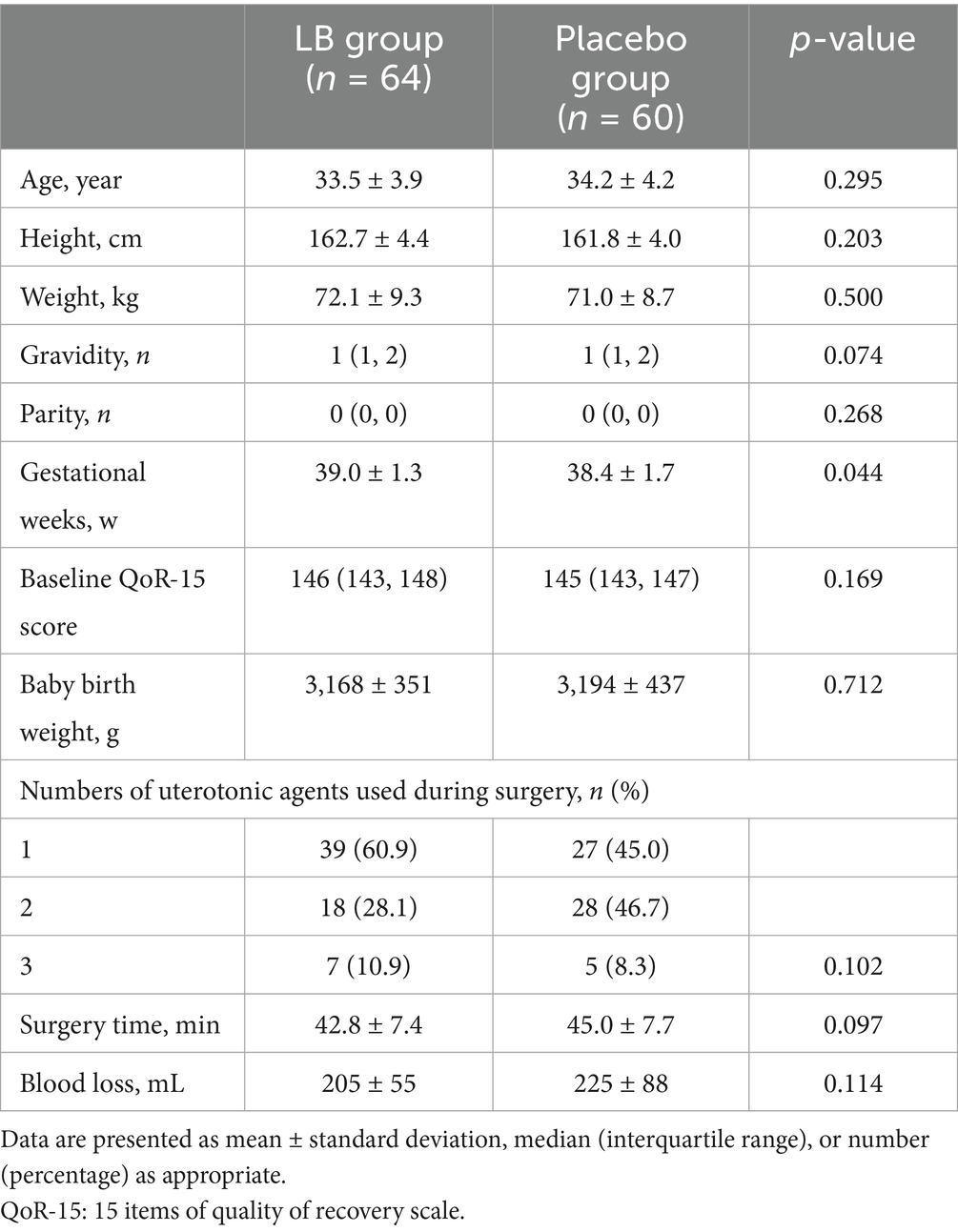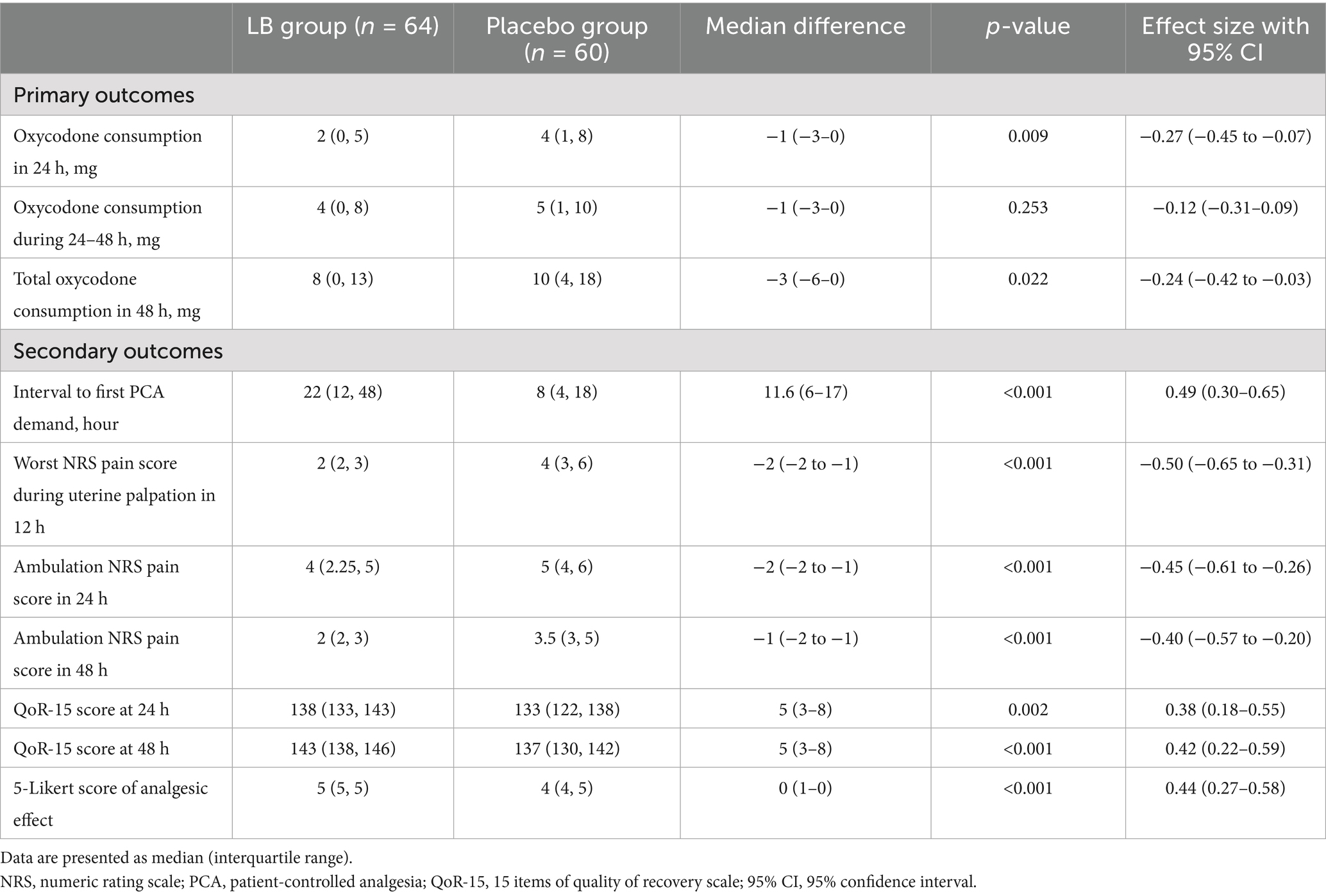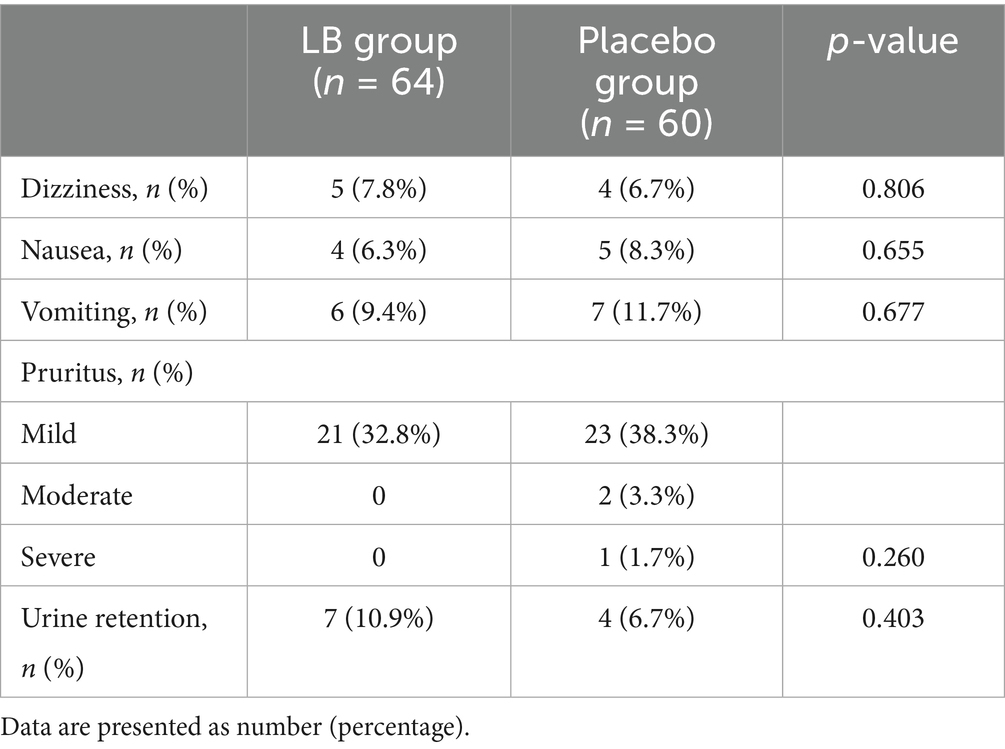- 1Department of Anaesthesiology, International Peace Maternity and Child Health Hospital, School of Medicine, Shanghai Jiao Tong University, Shanghai, China
- 2Shanghai Key Laboratory of Embryo Original Diseases, Shanghai, China
Background: Sustained release of bupivacaine can be achieved by encapsulating bupivacaine within multivesicular liposomes, providing localised analgesia for up to 72 h. This study aimed to evaluate whether a multimodal analgesic approach integrating epidural analgesia with liposomal bupivacaine enhanced transversus abdominis plane block could extend the interval to initial opioid use and thus reduce the total post-operative opioid requirements in women undergoing caesarean section.
Methods: Women scheduled for elective caesarean delivery under combined spinal-epidural anaesthesia were randomly assigned to a liposomal bupivacaine or placebo group. All participants were given 0.75% ropivacaine 15 mg intrathecally at L3–L4 interspace. Before surgical closure, 0.6 mg of epidural hydromorphone was administered. Bilateral ultrasound-guided lateral transversus abdominis plane blocks were performed after surgery. The liposomal bupivacaine group received 133 mg liposomal bupivacaine in 20 mL fluid per side, whereas the placebo control group received 20 mL saline per side. Postoperative analgesia included scheduled oral acetaminophen and self-administered boluses of oxycodone as needed. The primary outcomes were 24- and 48-h oxycodone consumption.
Results: A total of 128 women were enrolled. The median [interquartile range (IQR)] postoperative cumulative oxycodone consumption was significantly lower in the liposomal bupivacaine group than in the placebo group at 24 h [2 (0–5) mg vs. 4 (1–8) mg, p = 0.009] and 48 h [8 (0–13) mg vs. 10 (4–18) mg, p = 0.022], and the median (IQR) interval to first patient-controlled analgesia use was significantly longer in the liposomal bupivacaine group than in the placebo group [22 (12–48) vs. 8 (4–18) h; p < 0.001].
Conclusion: Epidural hydromorphone combined with liposomal bupivacaine enhances transversus abdominis plane block, prolongs analgesia duration and reduces opioid requirements in the first 48 h after caesarean-section.
Clinical trial registration: https://www.chictr.org.cn/showproj.html?proj=237618, Identifier [ChiCTR2400087477].
1 Introduction
Postoperative pain following caesarean-section delivery is a concern. Poorly managed acute pain can progress to chronic post-caesarean-section pain (CPCSP) (1, 2), which has a severe negative effect on quality of life, including maternal psychological well-being and infant care (3, 4). Uncontrolled acute pain is associated with a 2.5-fold increased risk of chronic pain and postnatal depression (4, 5). Ensuring optimal postoperative analgesia in women undergoing caesarean section is essential to prevent CPCSP and improve maternal outcomes.
Since the first trial investigating transversus abdominis plane (TAP) block for caesarean delivery was published in 2008 (6), several randomised controlled trials have demonstrated that the addition of TAP blocks has significant analgesic and opioid-sparing effects (7–9). However, subsequent trials revealed that the efficacy of TAP blocks is inferior to that of 100–200 μg of intrathecal morphine (10–12). This may be because of the shorter duration of analgesic effect of ropivacaine and bupivacaine, which are used in TAP blocks, compared with that of intrathecal morphine.
Liposomal bupivacaine (LB), a sustained-release formulation designed to provide up to 120 h of localised analgesia (13), provides a promising alternative to opioid analgesics. Encapsulating bupivacaine within multivesicular liposomes achieves gradual drug release, potentially bridging the analgesic gap between single-injection peripheral nerve blocks and extended-duration neuraxial opioids (14).
In China, where preservative-free morphine is not available, epidural opioids are widely used for postoperative analgesia. We hypothesised that the incorporation of LB-enhanced TAP block into a multimodal analgesic regimen anchored by epidural hydromorphone would significantly prolong the duration of effective analgesia and thereby reduce postoperative opioid requirements following caesarean delivery. We conducted a clinical trial to investigate this hypothesis.
2 Methods
2.1 Study design and participants
This double-blind, randomised controlled trial was approved by the Institutional Scientific Research and Clinical Trials Committee of International Peace Maternity and Child Health Hospital (GKLW-A-024-032-01) and was registered in advance with the Chinese Clinical Trials Registry (Registration No.: ChiCTR2400087477).
Pregnant women scheduled for elective caesarean delivery under spinal-epidural anaesthesia were enrolled between 1 August 2024 and 15 April 2025. Eligible patients were women aged 20–40 years, classified as American Society of Anaesthesiologists (ASA) physical status II, carrying singleton pregnancies at 37–42 weeks of gestation, who requested postoperative analgesia. The exclusion criteria included contraindications to neuraxial anaesthesia, allergy to study medications (LB, ropivacaine, hydromorphone, oxycodone, or acetaminophen), body mass index (BMI) > 36 kg/m2, gastrointestinal disorders, a history of substance abuse, or refusal to participate. Participants were withdrawn if protocol deviations occurred (e.g., epidural catheter failure, or noncompliance with oral analgesia).
2.2 Randomisation and blinding
Randomisation was performed using SPSS-generated random numbers (1:1 ratio), with assignments sealed in opaque envelopes. Envelopes were distributed to participants during preoperative assessments and opened by anaesthetists postoperatively to prepare study medications. Owing to visible differences between LB and saline, the anaesthetists administering the TAP block were unblinded, while the participants, research assistant in charge of follow-up, and data analysts remained blinded to the group allocation.
2.3 Trial procedure
Participants were recruited by a research assistant on the day before the surgery, informed of study protocols, and provided written informed consent. The Chinese version of the 15-item Quality of Recovery (QoR-15) scale was used to assess the participant’s preoperative condition. Each participant was then provided with a sealed randomisation envelope. Participants were instructed to fast from midnight prior to surgery.
On arrival in the operating room, intravenous access was established, and standard monitoring including electrocardiography, non-invasive blood pressure measurement, and pulse oximetry was initiated. Combined spinal-epidural anaesthesia was administered to the L3–L4 interspace and 15 mg of 0.75% ropivacaine was injected intrathecally, followed by epidural catheter placement. Sensory block level was assessed using pin-prick to ensure that the block reached to or above T6 before surgery; otherwise a 5-mL dose of 1% lidocaine was administered through the epidural catheter.
During the surgery, obstetricians administer oxytocin, carbetocin, ergometrine, or prostaglandin-based uterotonic agents based on the patient’s uterine contractions, with oxytocin being the standard intraoperative choice. The number of uterotonic agents used is documented before the patient leaves the operating room.
Before surgical closure, 0.6 mg of epidural hydromorphone (diluted in 6 mL saline) was administered. Participants were provided with a patient-controlled intravenous analgesia (PCIA) device (ZZB-III, APON Corp, Nantong, Jiangsu, China) containing oxycodone 30 mg in 60 mL saline, provided as 2-mL PCIA boluses with a 10-min lockout interval and no background infusion, after the surgery.
Immediately after completing the surgery, the randomisation envelope was opened by the anaesthetist, and bilateral ultrasound-guided lateral TAP blocks were performed. The LB group received 133 mg LB in 20 mL fluid per side, whereas the placebo group received 20 mL saline per side. Postoperative analgesia included scheduled oral acetaminophen (500 mg every 6 h for 48 h). Participants were permitted to self-administer PCIA boluses when the numeric rating scale (NRS) score of their abdominal pain, measured on a scale of 0–10, was >3.
A research assistant documented the 24- and 48-h oxycodone consumption, and interval to the first PCIA, and assessed resting pain, bed mobility pain, uterine palpation pain, and ambulation pain using the NRS at 6, 12, 24, and 48 h postoperatively; collected QoR-15 scores at 24 and 48 h; and recorded analgesia-related adverse effects. The analgesic pump was discontinued 48-h postoperatively, and the analgesic satisfaction score was assessed using a 5-point Likert scale.
2.4 Primary and secondary outcomes
The primary outcomes were oxycodone consumption within the first 24- and 48 h postoperatively. The secondary outcomes included interval to first PCIA of oxycodone; resting and bed mobility NRS scores at 6, 12, 24, and 48 h postoperatively; worst NRS scores in postoperative 12 h during uterine palpation; 24- and 48-h ambulation NRS pain scores; side effects of analgesia; 24- and 48-h QoR-15 scores; and analgesia satisfaction 48 h after surgery.
2.5 Sample size calculation and statistical analysis
The required sample size was calculated using PASS 2022. Due to the lack of prior data on oxycodone consumption amongst patients receiving epidural hydromorphone in conjunction with intravenous oxycodone following caesarean sections, sample size estimation was based on our clinical experience using the incidence of moderate-to-severe pain (NRS > 3) during ambulation at 24 h, which was the trigger for oxycodone consumption in our trial. In our clinic, the incidence of moderate-to-severe pain (NRS > 3) was about 60% amongst parturients during ambulation at 24 h. Assuming a 30% absolute reduction (from 60% to 30%), the required sample size was calculated as 53 patients per group (α = 0.05, power = 90%). Allowing for a 20% attrition rate, the target sample size was set at 128 participants, with 64 participants per group.
The “survminer” R software package was used to generate Kaplan–Meier curves and the log-rank test was used to compare the probability of participants having PCIA between the LB and placebo groups. Violin Plots of NRS for resting and bed mobility at 6, 12, 24, and 48 h postoperatively were generated for each group using the “ggplot2” R software package. The differences and effect sizes of outcomes related to postoperative analgesia effect were calculated using the “effsize” R software package. These statistical analyses were performed using R 3.4.4 (R Foundation for Statistical Computing, Vienna, Austria). Statistical significance was defined as a two-tailed p-value < 0.05.
Continuous data were presented as the mean ± SD or median and interquartile range (IQR), and groups were compared using t-tests or Mann–Whitney U tests, as appropriate. Categorical variables were presented as frequencies and percentages and groups were compared using chi-square or Fisher’s exact tests. Cliff’s delta was used as a nonparametric measure of effect size of LB compared with placebo, with values close to 0 signifying no effect and values close to −1 or +1 signifying a greater effect. These statistical analyses were performed using SPSS for Windows, version 26.0 (IBM Corp, Armonk, NY, USA). Statistical significance was defined as a two-tailed p-value < 0.05.
3 Results
3.1 Participant flow and baseline characteristics
The CONSORT flow diagram (Figure 1) outlines participant enrolment and allocation. A total of 154 potential were identified, of whom 26 were excluded because of preterm delivery, BMI > 36 kg/m2, allergy to acetaminophen, or refusal to participate. After these exclusions, a total of 128 participants were enrolled in the study. Three participants in the placebo group did not receive TAP block after surgery (two cases with postpartum haemorrhage exceeding 1,000 mL did not undergo TAP block due to concerns of coagulopathy potentially causing local hematoma. One case was withdrawn due to researcher forgetfulness) and one participant in the placebo group was unable to score her pain degree. These four participants were excluded from the analysis, leaving 64 participants in the LB group and 60 participants in the placebo group.
The baseline demographic and clinical characteristics were comparable between the LB and placebo groups, with no significant differences in age, anthropometric measures, obstetric history, neonatal birth weight, or intraoperative parameters (all p > 0.05). The mean gestational age was slightly higher in the LB group than in the placebo group (39.0 ± 1.3 vs. 38.4 ± 1.7 weeks; p = 0.044) but this difference was not clinically significant. The types of uterotonic agents administered did not differ significantly between groups (Table 1).
3.2 Primary outcome
The median (IQR) cumulative oxycodone consumption during the first 24 h after surgery was significantly lower in the LB group than in the placebo group [2 (0–5) mg vs. 4 (1–8) mg, p = 0.009]. The median (IQR) cumulative oxycodone consumption during the first 48 h after surgery was also significantly lower in the LB group than in the placebo group [8 (0–13) mg vs. 10 (4–18) mg, p = 0.022]. However, the median (IQR) oxycodone consumption during the period from 24 h to 48 h after surgery did not differ significantly between groups (Table 2).
3.3 Secondary outcomes
The Kaplan–Meier curves of the probability and numbers of participants without PCIA at each postoperative time-point are presented in Figure 2. The median (IQR) time to the first PCIA was significantly delayed in the LB group compared with the placebo group [22 (12–48) h vs. 8 (4–18) h, p < 0.001].
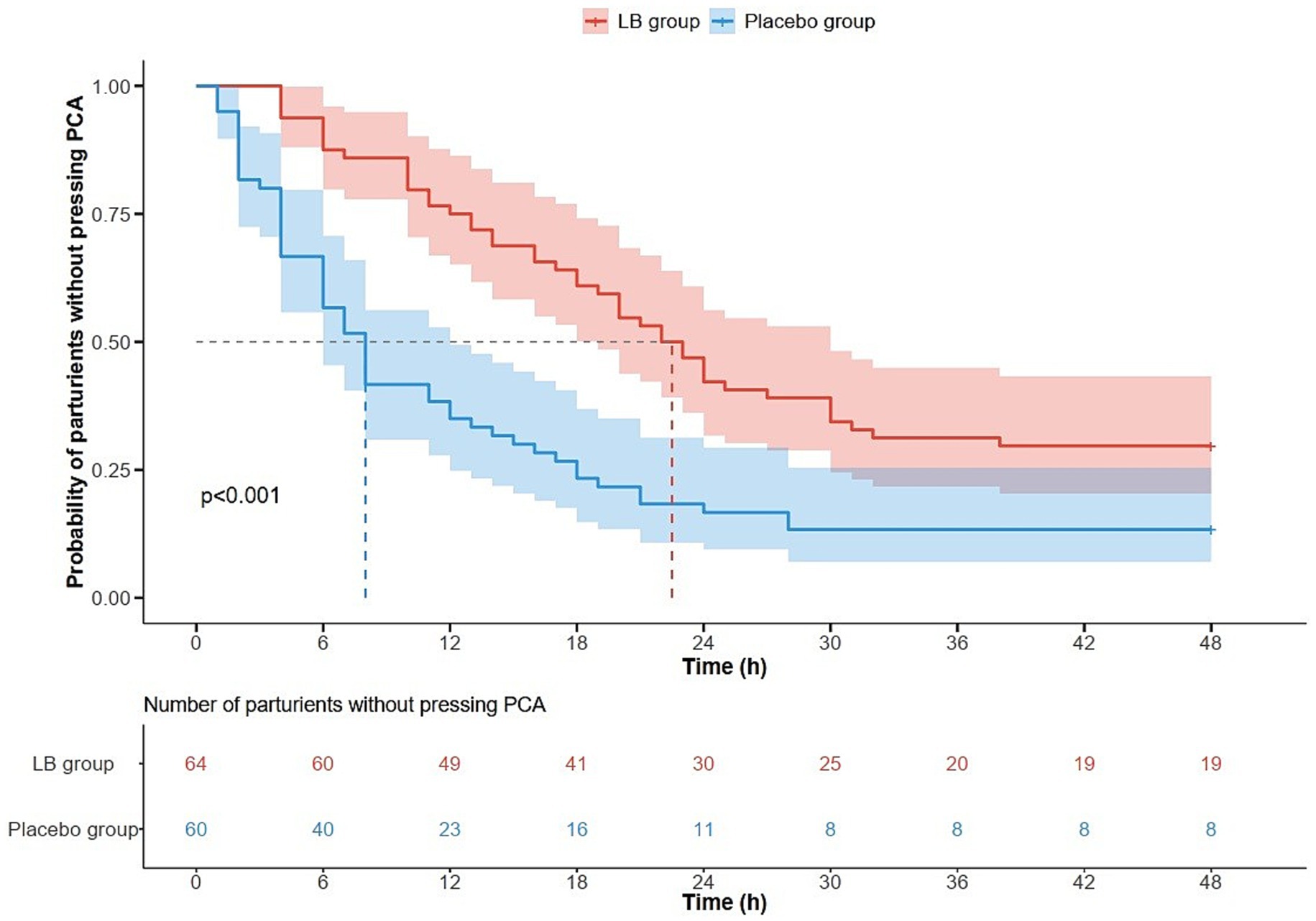
Figure 2. Kaplan–Meier curve of parturients without pressing PCA between LB and placebo group after caesarean delivery. The probability and numbers of parturients without pressing PCA at each postoperative time point are presented in this figure, and the time interval of the first oxycodone demand for 50% parturients was prolonged in the LB group [22 (12–48) vs. 8 (4–18) h, p < 0.001] compared with that of the placebo group. PCA, patient-controlled analgesia.
The resting and bed mobility NRS scores at 6, 12, 24, and 48 h postoperatively are presented in Figures 3, 4. The resting and bed mobility NRS scores in the LB group showed significantly better pain control than that in the placebo group at all time-points evaluated. The median (IQR) worst pain during uterine palpation at 12 h was significantly lower in the LB group than in the placebo group [NRS: 2 (2–3) vs. 4 (3–6); p < 0.001]. The ambulation pain scores at 24 h [4 (2.25–5) vs. 5 (4–6), p < 0.001] and 48 h [2 (2–3) vs. 3.5 (3–5), p < 0.001] postoperatively were also significantly lower in the LB group than in the placebo group (Table 2).
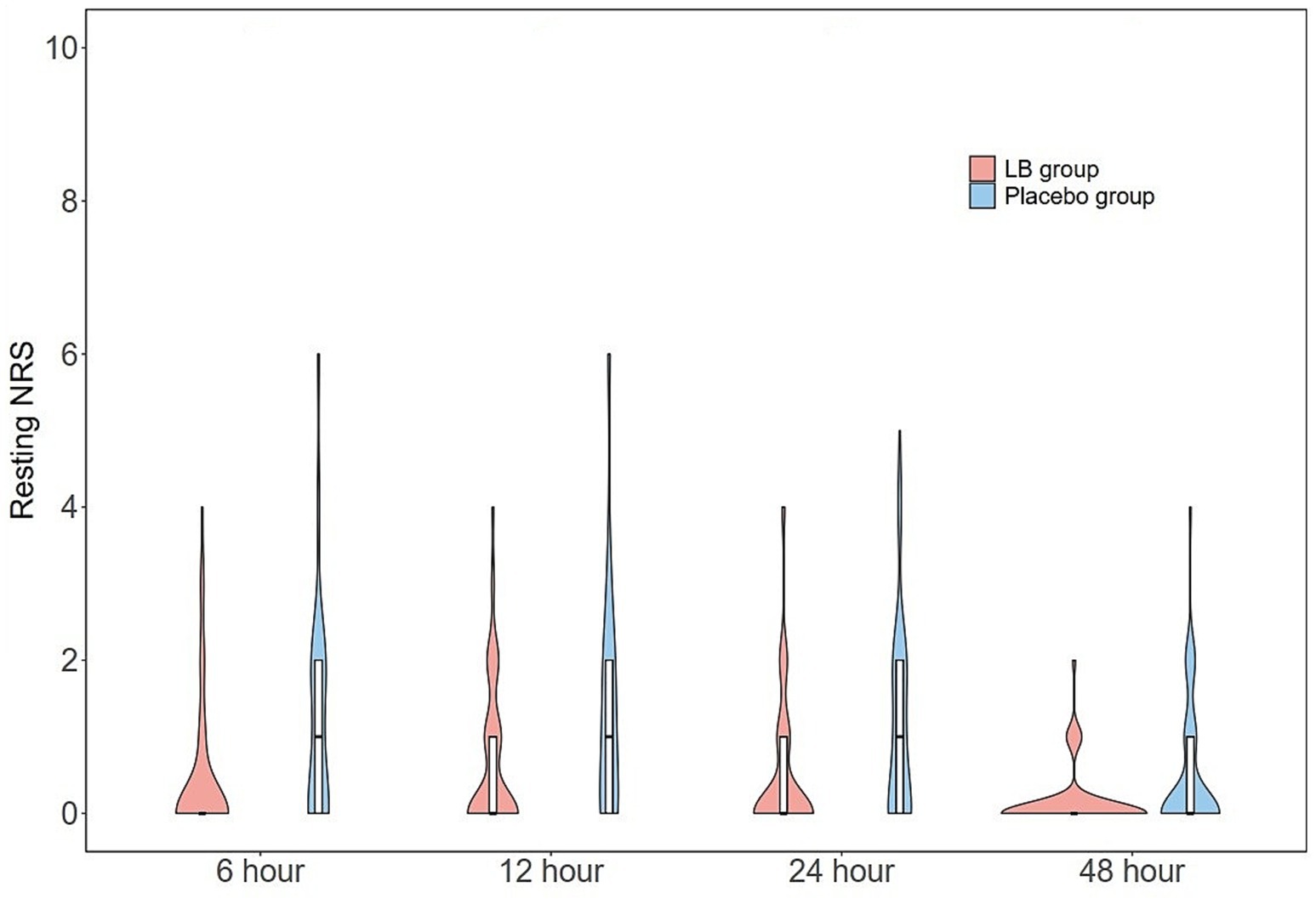
Figure 3. Violin plots of postoperative resting NRS scores at postoperative 6, 12, 24, and 48 h between LB and placebo group. The resting NRS scores in LB group were lower at postoperative 6 h (p < 0.001), at 12 and 24 h (p < 0.01), and at 48 h (p < 0.05) vs. placebo group. NRS, numeric rating scale.
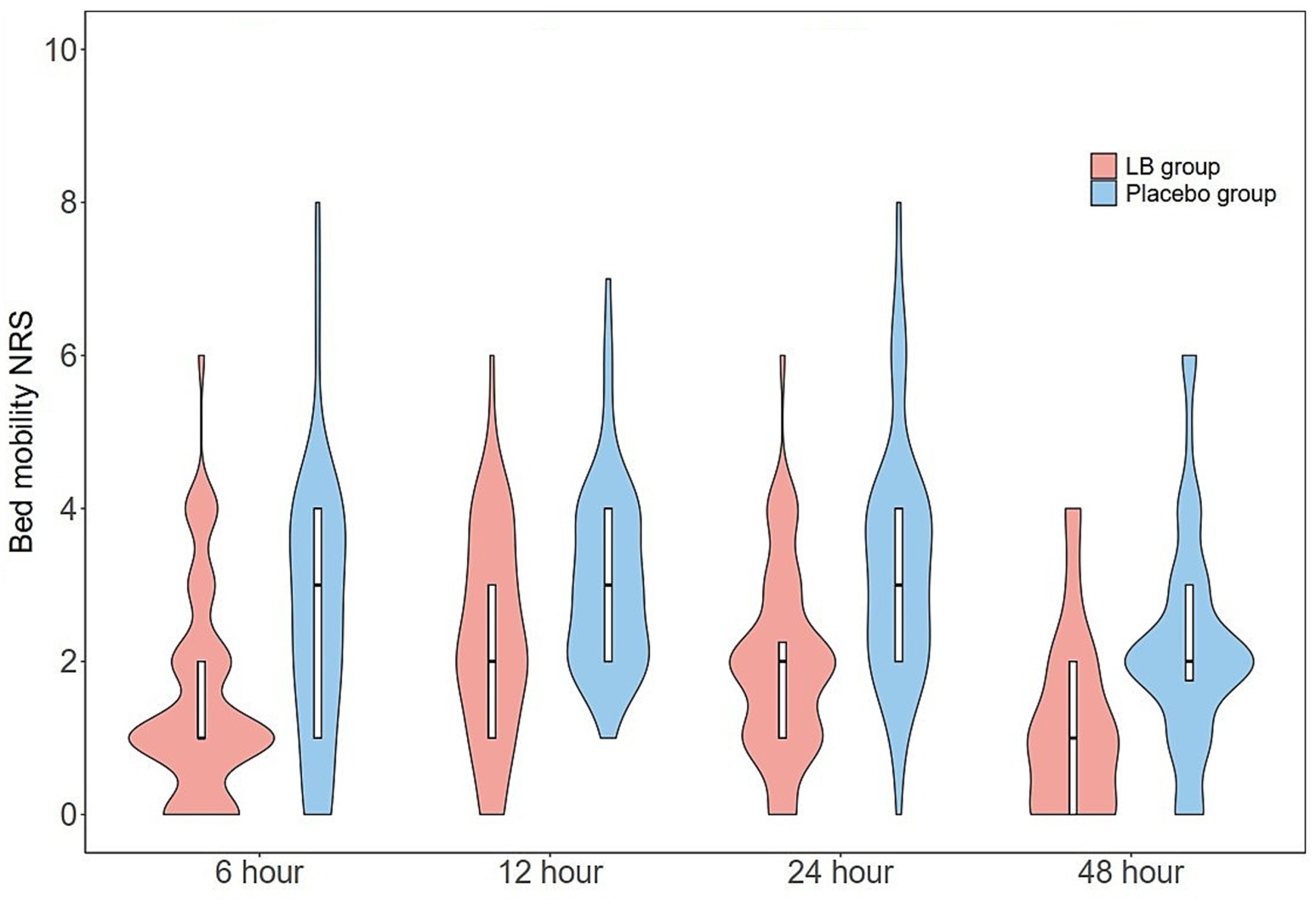
Figure 4. Violin plots of postoperative bed mobility NRS scores at postoperative 6, 12, 24, and 48 h between LB and placebo group. The bed mobility NRS scores in LB group were lower at postoperative 6 h (p < 0.0001), at 12 (p < 0.01), at 24 h and 48 h (p < 0.0001) vs. placebo group. NRS, numeric rating scale.
The QoR-15 scores revealed a 5-point greater median (IQR) recovery quality in the LB group compared with the placebo group at both 24 h [138 (133–143) vs. 133 (122–138), p = 0.002] and 48 h [143 (138–146) vs. 137 (130–142), p < 0.001] postoperatively. The median (IQR) analgesia satisfaction score at 48 h postoperatively was significantly higher in the LB group than in the placebo group [5 (5–5) vs. 4 (4–5), p < 0.001] (Table 2).
3.4 Safety
The adverse event profiles were comparable between the LB and placebo groups, with no statistically significant differences in the incidence of dizziness, nausea, vomiting, degree of pruritus, or urinary retention between the LB and placebo groups (Table 3).
4 Discussion
This study demonstrated that the multimodal analgesic approach integrating epidural analgesia with LB-enhanced TAP block reduces the cumulative total opioid requirements during the first 24 h and 48 h after caesarean delivery with lower NRSs in resting, bed mobility and ambulation, significantly extends the time delay to the initial opioid administration so that gain higher scores in QoR-15 and maternal satisfactory.
The TAP block was first described for caesarean delivery by McDonnell et al. (6) in 2008 and was later optimised using ultrasound guidance. TAP block has been shown to reduce somatic pain by targeting the thoracolumbar nerve branches (T6–L1) innervating the abdominal wall. Early studies highlighted their opioid-sparing potential in patients not receiving intrathecal morphine (ITM), and demonstrated significant reductions in postoperative pain scores and opioid consumption (7–9). However, the Enhanced Recovery After Caesarean Section (ERACS) guidelines prioritised neuraxial opioids such as ITM as the analgesic cornerstone, relegating TAP block to an adjunctive role (15). Despite showing promise in early studies, a recent review (16) and randomised controlled trials (10–12) have shown inconsistent opioid-sparing effects when TAP block is added to ITM-based protocols.
LB, encapsulating bupivacaine within multivesicular liposomes, achieves a sustained local analgesia effect for up to 120 h by gradual drug release (17, 18). The introduction LB reinvigorated interest of the use of TAP block in multimodal analgesia after caesarean delivery. Studies have demonstrated that patients treated with liposomal bupivacaine-enhanced TAP block shows reduced (13), or no more (19), morphine demand than those with ITM administration. Although TAP block can enhance postoperative multimodal analgesia, the magnitude of its analgesic effect varies depending on the type of local anaesthetic used (20).
Because preservative-free morphine is not available in China, we conducted a study to evaluate whether LB-enhanced TAP block augments epidural hydromorphone-based multimodal analgesia. This study demonstrated that the multimodal analgesic regimen integrating epidural analgesia with LB-enhanced lateral TAP block significantly prolonged the interval to first postoperative opioid requirement and resulted in reduced opioid consumption in 24 h and 48 h postoperatively. Furthermore, pain control in rest, bed mobility, ambulation, and uterine palpation in the 48 h postoperatively was significantly more effective in the LB group than in the placebo group. This study demonstrated that the time to first rescue analgesia in our method was comparable to that reported in recent literature for traditional intrathecal morphine (50 μg or 100 μg) combined with multimodal analgesia, with median of 23.5 h (95% CI: 15.2–28.3 h) and 22.9 h (95% CI: 13.8–28.3 h), respectively (21). Notably, this method showed a significant extension of the first rescue time compared to the use of liposomal bupivacaine (LB) as a single postoperative analgesic for caesarean delivery (median: 5 h, IQR: 3–15 h) (22). These further underscore the clinical advantages of our protocol in managing postoperative pain after caesarean delivery. However, when compared to the combination of intrathecal morphine with LB (median: 53.2 h, range: 2.3–345.2 h) (13), this advantage was less pronounced.
However, it should be noted that although the oxycodone consumption at 24 h and 48 h after liposomal bupivacaine-enhanced TAP blocks in this study showed statistically significant differences compared to the control group, the clinical relevance of these actual differences between the two groups may be limited. Additionally, no significant difference was observed in oxycodone usage between 24 h and 48 h between the two groups. This may be because during the early period before ambulation, while the control group had slightly higher pain NRS scores, neither group’s pain levels were sufficient to trigger patient-controlled analgesia. By the second day when ambulation was required, although the LB group demonstrated significantly lower pain scores during walking at 24 h, both groups frequently exceeded the threshold for PCIA activation, suggesting that standardized recovery protocols equalized opioid demand despite differences in nociceptive experiences between the LB and placebo groups. Furthermore, the lack of significant difference in opioid consumption between 24 h and 48 h postoperatively may reflect institutional protocols promoting early mobilization—a core principle of ERAS guidelines. This highlights the complex interplay between somatic pain control, behavioural recovery mandates, and opioid utilisation patterns in postoperative care (23). As the ERAS protocol may dilute the differences in opioid use between the two groups, future trials should control or stratify the amulation protocol to eliminate confounding factors introduced by ERAS.
In addition to epidural analgesia and TAP block, the multimodal analgesia regimen used in the study included scheduled oral acetaminophen and PCIA oxycodone. The epidural hydromorphone dose was 0.6 mg, which has been shown to provide superior postoperative analgesia than either higher or lower doses of epidural hydromorphone, while minimising the adverse effects (24, 25). Oral acetaminophen 500 mg was administered every 6 h, effectively controlling the total 24-h acetaminophen dose within the FDA-recommended maximum daily dose of 3,250 mg (26). The PCIA bolus dose was set at oxycodone 1 mg. Furthermore, this comprehensive multimodal analgesic strategy ensured the safety of postpartum analgesia following caesarean delivery and minimised interference with breastfeeding (27).
4.1 Strengths and limitations of the study
A strength of this study is the comprehensive evaluation of the analgesic effect of LB-enhanced TAP block using multiple endpoints: opioid rescue doses; interval to first PCIA demand; resting, bed mobility, ambulation and uterine palpation NRS pain scores; QoR-15; satisfaction score, and the use of Cliff’s delta to measure the effect size. These measures demonstrated the analgesic effect of LB-enhanced TAP block.
This study also has some limitations. First, since potential differences in practice settings (drug availability, analgesia protocols) that could influence outcomes, the single-centre design and modest sample size of the current study may limit generalizability, and control group with plain bupivacaine would have been valuable to evaluate the efficacy of the liposomal formulation. Further researches could be carried out to compare the LB and plain bupivacaine combined with epidural hydromorphone with multicentre or large cohort studies. Second, all participants fast from midnight according to the protocol of the study, however ERAS/ERAC recommendations clear fluids up to 2 h preoperatively. Third, the high cost of LB is a barrier to its widespread adoption, and further cost-effectiveness analyses are required. Fortunately, the price of liposomal bupivacaine in China has significantly dropped, and it now costs less than 54 USD. Finally, the duration of action of LB exceeds 72 h, a substantial proportion of women undergoing caesarean delivery are discharged prior to 72 h postoperatively. Consequently, we were unable to assess the analgesic efficacy of LB-enhance TAP block beyond 48 h. In future studies, postpartum pain situations can be followed up with telephone or online questionnaires for longer periods.
5 Conclusion
Epidural hydromorphone combined with LB-enhanced TAP block significantly prolongs analgesia duration and reduces opioid requirements during the first 24 h to 48 h after caesarean delivery. This regimen serves as a viable alternative for multimodal analgesia when ITM administration is precluded due to the unavailability of preservative-free morphine; however, its clinical implementation requires careful cost-benefit evaluation and patient preference assessment owing to the high cost of LB.
Data availability statement
The raw data supporting the conclusions of this article will be made available by the authors, without undue reservation.
Ethics statement
The studies involving humans were approved by The Institutional Scientific Research and Clinical Trials Committee of International Peace Maternity and Child Health Hospital. The studies were conducted in accordance with the local legislation and institutional requirements. Written informed consent for participation in this study was provided by the participants’ legal guardians/next of kin.
Author contributions
WM: Conceptualization, Data curation, Resources, Writing – original draft. YL: Data curation, Writing – original draft. SY: Formal analysis, Methodology, Writing – review & editing. QT: Data curation, Software, Writing – review & editing. YW: Data curation, Writing – review & editing. TX: Conceptualization, Data curation, Formal analysis, Funding acquisition, Project administration, Writing – review & editing.
Funding
The author(s) declare that financial support was received for the research and/or publication of this article. Disclosure of funding received for the work from the International Peace Maternity and Child Health Hospital (A Three-year Action Plan for Clinical Research Program, IPMCH2022CR-07) and Bethune Charity Foundation (Enzer Pain Management for the Medical Research Program, ezmr2022-023).
Conflict of interest
The authors declare that the research was conducted in the absence of any commercial or financial relationships that could be construed as a potential conflict of interest.
Generative AI statement
The authors declare that no Gen AI was used in the creation of this manuscript.
Any alternative text (alt text) provided alongside figures in this article has been generated by Frontiers with the support of artificial intelligence and reasonable efforts have been made to ensure accuracy, including review by the authors wherever possible. If you identify any issues, please contact us.
Publisher’s note
All claims expressed in this article are solely those of the authors and do not necessarily represent those of their affiliated organizations, or those of the publisher, the editors and the reviewers. Any product that may be evaluated in this article, or claim that may be made by its manufacturer, is not guaranteed or endorsed by the publisher.
References
1. Yimer, H, and Woldie, H. Incidence and associated factors of chronic pain after caesarean section: a systematic review. J Obstet Gynaecol Can. (2019) 41:840–54. doi: 10.1016/j.jogc.2018.04.006
2. Glare, P, Aubrey, KR, and Myles, PS. Transition from acute to chronic pain after surgery. Lancet. (2019) 393:1537–46. doi: 10.1016/S0140-6736(19)30352-6
3. Borges, NC, de Deus, JM, Guimarães, RA, Conde, DM, Bachion, MM, de Moura, LA, et al. The incidence of chronic pain following cesarean section and associated risk factors: a cohort of women followed up for three months. PLoS One. (2020) 15:e0238634. doi: 10.1371/journal.pone.0238634
4. Jin, J, Peng, L, Chen, Q, Zhang, D, Ren, L, Qin, P, et al. Prevalence and risk factors for chronic pain following cesarean section: a prospective study. BMC Anesthesiol. (2016) 16:99. doi: 10.1186/s12871-016-0270-6
5. Daly, B, Young, S, Marla, R, Riddell, L, Junkin, R, Weidenhammer, N, et al. Persistent pain after caesarean section and its association with maternal anxiety and socioeconomic background. Int J Obstet Anesth. (2017) 29:57–63. doi: 10.1016/j.ijoa.2016.10.004
6. McDonnell, JG, Curleey, G, Carney, J, Benton, A, Costello, J, Maharaj, CH, et al. The analgesic efficacay of transversus abdominis plane block after cesarean delivery: a randomized controlled trial. Anesth Analg. (2008) 106:186–91. doi: 10.1213/01.ane.0000290294.64090.f3
7. Belavy, D, Coliha, PJ, Hoe, M, and Phillip, F. Ultrasound-guided transversus abdominis plane block for caesarean delivery. Br J Anaesth. (2009) 103:726–30. doi: 10.1093/bja/aep235
8. Fusco, P, Cofini, V, Petrucci, E, Scimia, P, Pozone, T, Paladini, G, et al. Transversus abdominis plane block in the management of acute postoperative pain syndrome after caesarean section: a randomized controlled clinical trial. Pain Physician. (2016) 19:583–91.
9. Kupiec, A, Zwierzchowski, J, Kowal-Janicka, J, Goździk, W, Fuchs, T, Pomorski, M, et al. The analgesic efficiency of transversus abdominis plane (TAP) block after caesarean delivery. Ginekol Pol. (2018) 89:421–4. doi: 10.5603/GP.a2018.0072
10. McMorrow, RC, Ni Mhuircheartaigh, RJ, Ahmed, KA, Aslani, A, Ng, SC, Conrick-Martin, I, et al. Comparison of transversus abdominis plane block vs spinal morphine for pain relief after caesarean section. Br J Anaesth. (2011) 106:706–12. doi: 10.1093/bja/aer061
11. Lee, AJ, Palte, HD, Chehade, JM, Arheart, KL, Ranasinghe, JS, and Penning, DH. Ultrasound-guided bilateral transversus abdominis plane blocks in conjunction with intrathecal morphine for postcesarean analgesia. J Clin Anesth. (2013) 25:475–82. doi: 10.1016/j.jclinane.2013.05.004
12. Kwikiriza, A, Kiwanuka, JK, Firth, PG, Hoeft, MA, Modest, VE, and Ttendo, SS. The analgesic effects of intrathecal morphine in comparison with ultrasound-guided transversus abdominis plane block after caesarean section: a randomised controlled trial at a Ugandan regional referral hospital. Anaesthesia. (2019) 74:167–73. doi: 10.1111/anae.14467
13. Nedeljkovic, SS, Kett, A, Vallejo, MC, Horn, JL, Carvalho, B, Bao, X, et al. Transversus abdominis plane block with liposomal bupivacaine for pain after cesarean delivery in a multicenter, randomized, double-blind, controlled trial. Anesth Analg. (2020) 131:1830–9. doi: 10.1213/ANE.0000000000005075
14. Antony, KM, McDonald, RC, Gaston, L, Hetzel, S, and Li, Z. Surgical transversus abdominis plane block with liposomal bupivacaine at cesarean: a pilot randomized trial. Am J Obstet Gynecol MFM. (2024) 6:101273. doi: 10.1016/j.ajogmf.2023.101273
15. El-Tallawy, SN, Pergolizzi, JV, Amlih, HF, Fairaq, MM, Awaleh, FI, Alsubaie, AT, et al. Enhancing postoperative analgesia after cesarean section: insights into transversus abdominis plane block, intrathecal opioids, and other analgesic techniques. Cureus. (2024) 16:e72773. doi: 10.7759/cureus.72773
16. Tran, DQ, Bravo, D, Leurcharusmee, P, and Neal, JM. Transversus abdominis plane block: a narrative review. Anesthesiology. (2019) 131:1166–90. doi: 10.1097/ALN.0000000000002842
17. Manna, S, Wu, Y, Wang, Y, Koo, B, Chen, L, Petrochenko, P, et al. Probing the mechanism of bupivacaine drug release from multivesicular liposomes. J Control Release. (2019) 294:279–87. doi: 10.1016/j.jconrel.2018.12.029
18. EXPAREL (bupivacaine liposome injectable suspension) (2018). US package insert. Pacira Biosciences, Inc. http://www.accessdata.fda.gov/drugsatfda_docs/label/2018/022496s9lbl.pdf (Accessed July 8, 2020)
19. Habib, AS, Nedeljkovic, SS, Horn, JL, Smiley, RM, Kett, AG, Vallejo, MC, et al. Randomized trial of transversus abdominis plane block with liposomal bupivacaine after cesarean delivery with or without intrathecal morphine. J Clin Anesth. (2021) 75:110527. doi: 10.1016/j.jclinane.2021.110527
20. Ammar, AS, and Mahmoud, KM. Effect of adding dexamethasone to bupivacaine on transversus abdominis plane block for abdominal hysterectomy: a prospective randomized controlled trial. Saudi J Anaesth. (2012) 6:229–33. doi: 10.4103/1658-354X.101213
21. Hatter, KH, Shugart, NW, Paladugu, N, Nitchie, H, Wolf, B, and Hebbar, L. Low dose intrathecal morphine for post-cesarean analgesia with scheduled multimodal pain regimen: a prospective, randomized, open blinded end-point study. Int J Obstet Anesth. (2025) 62:104361. doi: 10.1016/j.ijoa.2025.104361
22. Liu, HH, Qiu, D, Xu, DR, Yang, JJ, and Teng, PL. Recovery quality of transversus abdominis plane block with liposomal bupivacaine after cesarean delivery: a randomized trial. J Clin Anesth. (2024) 99:111608. doi: 10.1016/j.jclinane.2024.111608
23. Macones, GA, Caughey, AB, Wood, SL, Wrench, IJ, Huang, J, Norman, M, et al. Guidelines for postoperative care in cesarean delivery: enhanced recovery after surgery (ERAS) society recommendations (part 3). Am J Obstet Gynecol. (2019) 221:247.e1–9. doi: 10.1016/j.ajog.2019.04.012
24. Yang, M, Wang, L, Chen, H, Tang, Y, and Chen, X. Postoperative analgesic effects of different doses of epidural hydromorphone coadministered with ropivacaine after cesarean section: a randomized controlled trial. Pain Res Manag. (2019) 2019:9054538. doi: 10.1155/2019/9054538
25. Liu, QQ, Mao, M, Lin, NH, Xu, CY, Li, Q, Jiang, CS, et al. Effective dose of epidural hydromorphone for analgesia following caesarean section in using modified Dixon sequential method. J Pain Res. (2024) 17:3671–9. doi: 10.2147/JPR.S480917
26. Krenzelok, EP. The FDA acetaminophen advisory committee meeting – what is the future of acetaminophen in the United States? The perspective of a committee member. Clin Toxicol Phila. (2009) 47:784–9. doi: 10.1080/15563650903232345
Keywords: epidural analgesia, transversus abdominis plane, liposomal bupivacaine, caesarean delivery, postoperative pain
Citation: Ma W, Long Y, Ye S, Tao Q, Wang Y and Xu T (2025) Epidural analgesia combined with transversus abdominis plane block with liposomal bupivacaine reduces pain after caesarean delivery: a double-blind, randomised controlled trial. Front. Med. 12:1653815. doi: 10.3389/fmed.2025.1653815
Edited by:
Luca Giacomelli, Polistudium srl, ItalyReviewed by:
Sara Agyemang Antwi, Kumasi Polytechnic, GhanaHarrie Toms John, Epsom and St. Helier University Hospitals NHS Trust, United Kingdom
Ahmet Pınarbaşı, Odak Hospital, Türkiye
Mohan Sunkad, USM-KLE International Medical Programme, India
Copyright © 2025 Ma, Long, Ye, Tao, Wang and Xu. This is an open-access article distributed under the terms of the Creative Commons Attribution License (CC BY). The use, distribution or reproduction in other forums is permitted, provided the original author(s) and the copyright owner(s) are credited and that the original publication in this journal is cited, in accordance with accepted academic practice. No use, distribution or reproduction is permitted which does not comply with these terms.
*Correspondence: Yang Wang, d2FuZ3lhbmc5ODczMTFAMTYzLmNvbQ==; Tao Xu, dG93ZXJ4dXRhb0AxNjMuY29t
†These authors have contributed equally to this work and share first authorship
 Wei Ma1,2†
Wei Ma1,2† Tao Xu
Tao Xu